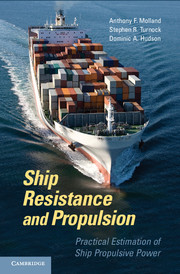Book contents
- Frontmatter
- Contents
- Preface
- Nomenclature
- Abbreviations
- Figure Acknowledgements
- 1 Introduction
- 2 Propulsive Power
- 3 Components of Hull Resistance
- 4 Model-Ship Extrapolation
- 5 Model-Ship Correlation
- 6 Restricted Water Depth and Breadth
- 7 Measurement of Resistance Components
- 8 Wake and Thrust Deduction
- 9 Numerical Estimation of Ship Resistance
- 10 Resistance Design Data
- 11 Propulsor Types
- 12 Propeller Characteristics
- 13 Powering Process
- 14 Hull Form Design
- 15 Numerical Methods for Propeller Analysis
- 16 Propulsor Design Data
- 17 Applications
- Appendix A1 Background Physics
- Appendix A2 Derivation of Eggers Formula for Wave Resistance
- Appendix A3 Tabulations of Resistance Design Data
- Appendix A4 Tabulations of Propulsor Design Data
- Index
- References
17 - Applications
Published online by Cambridge University Press: 07 September 2011
- Frontmatter
- Contents
- Preface
- Nomenclature
- Abbreviations
- Figure Acknowledgements
- 1 Introduction
- 2 Propulsive Power
- 3 Components of Hull Resistance
- 4 Model-Ship Extrapolation
- 5 Model-Ship Correlation
- 6 Restricted Water Depth and Breadth
- 7 Measurement of Resistance Components
- 8 Wake and Thrust Deduction
- 9 Numerical Estimation of Ship Resistance
- 10 Resistance Design Data
- 11 Propulsor Types
- 12 Propeller Characteristics
- 13 Powering Process
- 14 Hull Form Design
- 15 Numerical Methods for Propeller Analysis
- 16 Propulsor Design Data
- 17 Applications
- Appendix A1 Background Physics
- Appendix A2 Derivation of Eggers Formula for Wave Resistance
- Appendix A3 Tabulations of Resistance Design Data
- Appendix A4 Tabulations of Propulsor Design Data
- Index
- References
Summary
Background
The overall ship powering process is shown in Figure 2.3. A number of worked examples are presented to illustrate typical applications of the resistance and propulsor data and methodologies for estimating ship propulsive power for various ship types and size. The examples are grouped broadly into the estimation of effective power and propeller/propulsor design for large and small displacement ships, semi-displacement ships, planing craft and sailing vessels.
The resistance data are presented in Chapter 10 together with tables of data in Appendix A3. The propeller data are presented in Chapter 16, together with tables of data in Appendix A4.
- Type
- Chapter
- Information
- Ship Resistance and PropulsionPractical Estimation of Propulsive Power, pp. 418 - 472Publisher: Cambridge University PressPrint publication year: 2011



